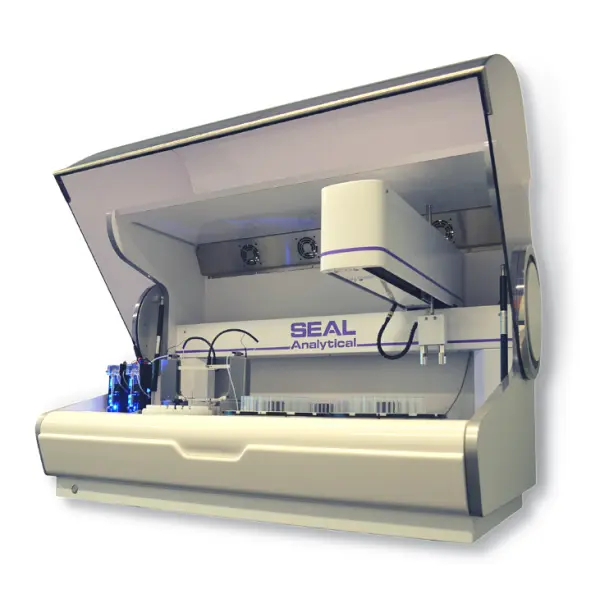Product Overview:
The SEAL AQ700 discrete analyzer for nutrient analysis is engineered specifically to meet the needs of the highest-throughput environmental laboratories. It was designed in collaboration with these lab, ensuring the wide-spread needs for automation, hardware, and software were met. It is ideal for applications that require a wide range of chemistries, limits of detection that ensure compliance with regulatory requirements and seamless integration with LIMS.
Four robotic arms and four sample trays utilize automated colorimetric reactions to facilitate fast, precise, and reproducible results. Combining a high level of automation, including QR code sample scanning, with high-capacity performance and long walkaway times for unattended operation, the AQ700 is a proven tool for taking nutrient analysis to a whole new level of efficiency.
Why Select the AQ700:
Automation
- True unattended operation with the ability to run overnight
- Integrated barcode scanning for samples and reagents
- Automated standard preparation and dilution of over-range samples
- True automated sample blanking for background color correction
- Automated sample spiking
Efficiency
- Ultra-low reagent consumption
- Ability to add samples after the run has started
- Advanced robotics for faster sample preparation per hour
- Easy maintenance & easy-change syringe
Compliance
- No carryover or cross-contamination
- Standard 10 mm quartz cuvette
- Lower detection limits
- Chemical reaction brought to full completion emulating manual and segmented flow methods
Support
- Visual manuals and descriptive checklists
- Immediate support available from SEAL chemists via email, phone, screenshare, or video call
- In-depth training during installation
- Guides and webinars available for continued learning
Highlights of the AQ700:
Increased Data Handling and Automation
Find the highest throughput and capacity with two sampling arms, increased motor speed, and four on-board sample trays automatically handled by a robotic arm.
With built-in barcode scanners for reagents and samples, the AQ700 automates not just the test, but also data entry and handling, providing even more automation for busy laboratories. AQ software for SEAL discrete analyzers also offers flexible import and export options for full compatibility with LIMS.
Lower Detection Limits & Higher Reproducibility
An optically pure quartz cuvette provides a 10mm pathlength for maximum sensitivity and lower detection limits. Quartz is superior to styrene for sample analysis, ensuring excellent precision.
Minimal Reagent Usage
SEAL discrete analyzers use just 20 - 400 μL of reagent per test, lowering reagent costs and consumption as well as potential hazardous waste. On-board reagent cooling keeps reagents fresh through long testing periods, and built-in reagent level sensors ensure sufficient volumes for the tests before the run starts. Expiration dates are tracked in the software to remind analysts when it’s time to remake a solution.
Inexpensive Consumables
With detection taking place in a 10 mm flow-through quartz cuvette rather than in reaction wells, consumable costs are significantly lowered as reaction wells are not used in the optical read. Constant heating and a programmable reaction time ensure reactions reach completion before transfer from the reaction well to the cuvette.
Cadmium Reduction for Wider Matrix Compatibility
All SEAL discrete analyzers can run all types of nitrate reduction for colorimetric analysis of nitrate. Our most popular method is cadmium reduction due to the low cost and ability to handle a wide-range of sample types including wastewater, drinking water, industrial, and seawater samples. With cadmium reduction, all hazardous waste is contained in solid form in the cadmium coil for easier, safer disposal, rather than liquid form in other reduction methods. The cadmium coil can be regenerated in-line automatically, saving valuable analyst time.
Eliminate cross-contamination
A feature unique to SEAL discrete analyzers, our probe washer moves with the sample probes wiping the probe clean before moving to a new location, eliminating cross-contamination of samples, reagents, and diluents.
